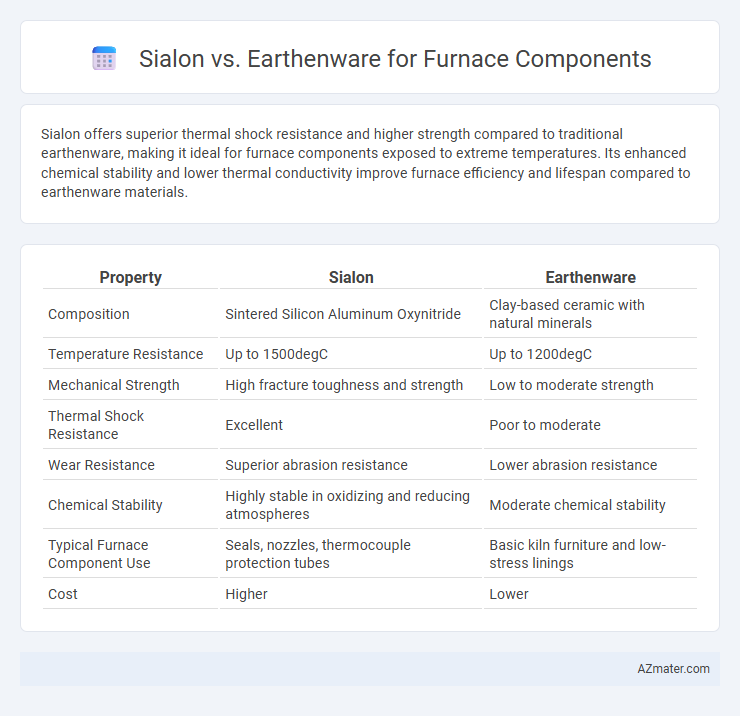Sialon offers superior thermal shock resistance and higher strength compared to traditional earthenware, making it ideal for furnace components exposed to extreme temperatures. Its enhanced chemical stability and lower thermal conductivity improve furnace efficiency and lifespan compared to earthenware materials.
Table of Comparison
| Property | Sialon | Earthenware |
|---|---|---|
| Composition | Sintered Silicon Aluminum Oxynitride | Clay-based ceramic with natural minerals |
| Temperature Resistance | Up to 1500degC | Up to 1200degC |
| Mechanical Strength | High fracture toughness and strength | Low to moderate strength |
| Thermal Shock Resistance | Excellent | Poor to moderate |
| Wear Resistance | Superior abrasion resistance | Lower abrasion resistance |
| Chemical Stability | Highly stable in oxidizing and reducing atmospheres | Moderate chemical stability |
| Typical Furnace Component Use | Seals, nozzles, thermocouple protection tubes | Basic kiln furniture and low-stress linings |
| Cost | Higher | Lower |
Introduction to Sialon and Earthenware in Furnace Applications
Sialon, a silicon aluminum oxynitride ceramic, offers exceptional thermal shock resistance and mechanical strength, making it ideal for high-temperature furnace components. Earthenware, a traditional clay-based ceramic, provides cost-effective heat insulation but lacks the durability and thermal stability required for intense furnace environments. The advanced properties of Sialon significantly enhance furnace longevity and performance compared to conventional earthenware materials.
Material Composition and Structure Comparison
Sialon, a silicon-aluminum-oxynitride ceramic, exhibits superior mechanical strength and thermal shock resistance due to its covalently bonded crystal structure, making it highly suitable for high-temperature furnace components. Earthenware, primarily composed of clay and other natural minerals, features a porous, crystalline structure with lower thermal stability and mechanical strength, limiting its use in demanding thermal environments. The dense, engineered microstructure of Sialon offers enhanced durability and corrosion resistance compared to the more porous and brittle composition of traditional earthenware.
Thermal Resistance: Sialon vs Earthenware
Sialon exhibits superior thermal resistance compared to earthenware, maintaining structural integrity at temperatures exceeding 1600degC, whereas earthenware typically withstands up to 1200degC before degradation. The silicon-aluminum-oxygen-nitrogen composition of Sialon provides exceptional resistance to thermal shock and oxidation, making it ideal for high-temperature furnace components. Earthenware's porous structure leads to lower thermal stability and faster wear under cyclic thermal stress, limiting its use in advanced furnace applications.
Mechanical Strength and Durability Analysis
Sialon exhibits superior mechanical strength and higher fracture toughness compared to earthenware, making it ideal for furnace components subjected to extreme thermal and mechanical stress. Its enhanced durability arises from excellent resistance to thermal shock, oxidation, and chemical attack, outperforming conventional earthenware materials that tend to suffer from brittleness and lower thermal stability. The combination of high flexural strength and long-term wear resistance positions Sialon as a preferred ceramic material for advanced furnace linings and components.
Chemical Stability Under Extreme Conditions
Sialon exhibits superior chemical stability compared to earthenware when exposed to extreme furnace conditions, maintaining structural integrity at temperatures exceeding 1400degC and resisting corrosion from reactive slags and gases. Earthenware, predominantly composed of clay-based ceramics, tends to degrade more rapidly due to its porous nature and lower resistance to chemical attack under high-temperature oxidative and reductive environments. The enhanced resistance of Sialon to thermal shock and chemical erosion makes it a preferred material for furnace components in demanding industrial applications.
Wear and Corrosion Resistance
Sialon ceramics exhibit superior wear and corrosion resistance compared to traditional earthenware, making them ideal for furnace components exposed to harsh environments. Their high hardness and chemical stability ensure prolonged durability under abrasive and corrosive conditions, reducing maintenance and downtime. Earthenware, while cost-effective, lacks the advanced resistance properties of Sialon, resulting in faster degradation and shorter service life in furnace applications.
Lifespan and Maintenance Requirements
Sialon ceramic components offer superior lifespan compared to earthenware due to their high thermal shock resistance and exceptional mechanical strength, reducing the frequency of replacements in furnaces. Maintenance requirements for Sialon are minimal as they withstand corrosion and wear better than earthenware, which tends to degrade faster under high temperatures, leading to increased repair and downtime. The enhanced durability and lower maintenance demands of Sialon components result in improved overall furnace efficiency and cost-effectiveness.
Cost-Effectiveness and Availability
Sialon offers superior mechanical strength and thermal shock resistance compared to earthenware, leading to longer service life and reduced replacement costs in furnace components. However, earthenware remains more cost-effective upfront and enjoys wider availability due to established manufacturing processes and regional material access. Balancing initial investment with durability, Sialon suits high-performance applications, while earthenware is preferred for budget-constrained or locally sourced needs.
Environmental Impact and Sustainability
Sialon ceramics offer superior environmental sustainability compared to traditional earthenware for furnace components, as their high thermal efficiency reduces energy consumption and greenhouse gas emissions during operation. Earthenware materials typically require more frequent replacement due to lower durability, leading to increased resource extraction and waste generation over time. The longer lifespan and recyclability of Sialon components significantly lower the overall carbon footprint and support sustainable industrial practices.
Application Suitability: Choosing the Right Material for Furnace Components
Sialon ceramics offer superior thermal shock resistance and mechanical strength, making them ideal for high-temperature furnace components subjected to rapid temperature fluctuations and harsh environments. Earthenware, while cost-effective and easy to manufacture, lacks the thermal durability and structural integrity required for critical furnace parts operating at extreme temperatures. Selecting Sialon enhances furnace longevity and performance in demanding industrial applications, whereas earthenware suits low-temperature or non-critical insulation uses.

Infographic: Sialon vs Earthenware for Furnace component
 azmater.com
azmater.com